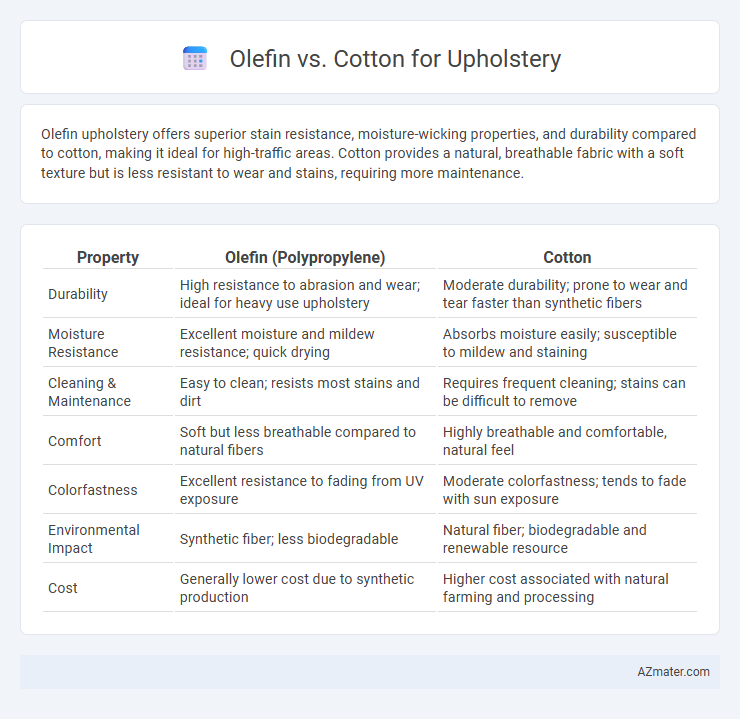Olefin upholstery offers superior stain resistance, moisture-wicking properties, and durability compared to cotton, making it ideal for high-traffic areas. Cotton provides a natural, breathable fabric with a soft texture but is less resistant to wear and stains, requiring more maintenance.
Table of Comparison
| Property | Olefin (Polypropylene) | Cotton |
|---|---|---|
| Durability | High resistance to abrasion and wear; ideal for heavy use upholstery | Moderate durability; prone to wear and tear faster than synthetic fibers |
| Moisture Resistance | Excellent moisture and mildew resistance; quick drying | Absorbs moisture easily; susceptible to mildew and staining |
| Cleaning & Maintenance | Easy to clean; resists most stains and dirt | Requires frequent cleaning; stains can be difficult to remove |
| Comfort | Soft but less breathable compared to natural fibers | Highly breathable and comfortable, natural feel |
| Colorfastness | Excellent resistance to fading from UV exposure | Moderate colorfastness; tends to fade with sun exposure |
| Environmental Impact | Synthetic fiber; less biodegradable | Natural fiber; biodegradable and renewable resource |
| Cost | Generally lower cost due to synthetic production | Higher cost associated with natural farming and processing |
Introduction to Olefin and Cotton Upholstery Fabrics
Olefin upholstery fabric, made from synthetic polypropylene fibers, offers exceptional durability, stain resistance, and colorfastness, making it ideal for high-traffic areas. Cotton upholstery fabric, derived from natural plant fibers, provides breathability, softness, and a comfortable texture but may require more maintenance due to its susceptibility to staining and wear. Both fabrics present distinct benefits, with Olefin excelling in resilience and moisture resistance, while cotton emphasizes natural comfort and aesthetic appeal.
Composition and Manufacturing of Olefin vs Cotton
Olefin, also known as polypropylene, is a synthetic fiber made from petrochemicals through a polymerization process, resulting in a lightweight, moisture-resistant, and durable fabric ideal for upholstery. In contrast, cotton is a natural fiber harvested from cotton plants, processed by ginning, spinning, and weaving, known for its breathability and softness but lower resistance to stains and fading. Olefin's manufacturing allows for high colorfastness and resistance to chemicals, whereas cotton's natural composition offers comfort but requires special treatments to enhance durability for upholstery applications.
Durability and Wear Resistance
Olefin fibers exhibit superior durability and wear resistance compared to cotton, making them ideal for upholstery subjected to heavy use and frequent abrasion. Olefin's intrinsic resistance to stains, moisture, and UV exposure enhances its longevity, while cotton tends to wear down faster due to its natural fiber composition and susceptibility to fading and pilling. Upholstery made from olefin maintains structural integrity and appearance over time, outperforming cotton in high-traffic environments.
Stain Resistance and Ease of Cleaning
Olefin upholstery fabric is highly stain-resistant due to its synthetic fibers that repel moisture and resist oil-based stains, making it easier to clean with mild detergents or water-based solutions. Cotton upholstery, while breathable and comfortable, tends to absorb spills quickly and may stain more easily, often requiring professional cleaning or specialized stain removers for effective care. Choosing olefin over cotton enhances durability and simplifies maintenance, especially in high-traffic or spill-prone areas.
Comfort and Texture Comparison
Olefin upholstery offers a smooth, soft texture with excellent resistance to moisture and stains, making it comfortable and practical for everyday use. Cotton provides a natural, breathable fabric with a cozy, warm feel, yet it tends to absorb moisture and may wear faster over time. Choosing between Olefin and Cotton depends on balancing Olefin's durability and easy maintenance with Cotton's organic softness and tactile warmth.
Colorfastness and Fading Over Time
Olefin offers superior colorfastness and resistance to fading compared to cotton, making it an excellent choice for upholstery exposed to direct sunlight. Olefin's synthetic fibers resist UV damage and maintain vibrant colors longer, while cotton tends to fade more quickly due to its natural fiber composition. For high-traffic or sunlit areas, olefin upholstery ensures lasting color retention and durability.
Environmental Impact and Sustainability
Olefin fabric, derived from polypropylene, is highly resistant to moisture, mold, and UV rays, resulting in longer product life and reduced need for chemical treatments, which lowers its environmental footprint compared to cotton. Cotton upholstery, while biodegradable and renewable, often requires intensive water usage, pesticides, and fertilizers during cultivation, contributing to greater environmental degradation. Olefin's production consumes less water and energy, making it a more sustainable choice for eco-conscious upholstery applications.
Cost Differences and Budget Considerations
Olefin upholstery fabric offers a cost-effective alternative to cotton, with prices generally 20-40% lower due to its synthetic composition and durability. Cotton typically demands a higher budget, attributed to its natural fibers and premium texture, often making it 30-50% more expensive than Olefin. Budget considerations should weigh the balance between Olefin's affordability and stain resistance against cotton's breathability and comfort, impacting long-term value based on use and maintenance needs.
Ideal Uses: Where Each Fabric Performs Best
Olefin fabric excels in high-traffic areas and outdoor upholstery due to its resistance to stains, moisture, and fading, making it ideal for families with children or pets and patio furniture. Cotton upholstery offers superior breathability and comfort, best suited for indoor settings like living rooms and bedrooms where aesthetic appeal and softness are prioritized. Choosing between olefin and cotton depends on whether durability and easy maintenance or natural texture and coziness are the primary needs for your upholstery project.
Choosing Between Olefin and Cotton for Your Upholstery
Olefin fabric offers superior durability, stain resistance, and moisture-wicking properties, making it ideal for high-traffic upholstery in homes with pets or children. Cotton upholstery provides a natural, breathable texture with excellent comfort, though it requires more maintenance and is prone to fading and staining. Selecting between olefin and cotton depends on balancing durability and ease of care against aesthetic preference and softness for your specific upholstery needs.

Infographic: Olefin vs Cotton for Upholstery
 azmater.com
azmater.com